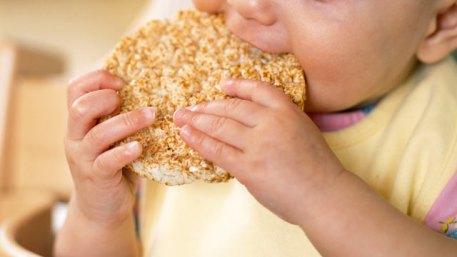
Arsenic is an element that’s commonly found in the environment. It’s primarily found as “inorganic Arsenic”, which is highly toxic. Due to the way rice is grown (in flooded conditions), it has around ten times more inorganic Arsenic than other foods.
There are several reports, including one published in JAMA Pediatrics recently, which looked into Arsenic exposure in infants and children. The results showed that urinary Arsenic concentrations were higher for those who ate infant rice cereal or snacks than for those who did not.
Given that the first food for most babies in the Western world is rice porridge/cereal, these are very concerning findings. Babies are more sensitive to adverse effects associated with Arsenic, and their little bodies are not able to eliminate toxins efficiently. Inorganic Arsenic exposure has not only been linked to cancer, but also neurological, cardiovascular, respiratory and metabolic diseases.
In fact, rice milk is so high in inorganic Arsenic that in the UK, it’s advised that children under 4.5 years old should avoid drinking rice milk. If you’re avoiding giving your little ones cow’s milk, rather than exclusively consuming rice milk as an alternative, I recommend a rotation of non-dairy milks, such as rice, coconut, oat, almond and soy.
What can you do to minimise Arsenic exposure?
- Don’t give your baby rice porridge/cereal as their first food, or a large amount of rice-based products. If you want to give you baby porridge at some stage when introducing solids, use oats or quinoa.
- Rinse raw rice thoroughly before cooking, and use a ratio of six cups water to one cup rice for cooking as it helps to remove inorganic Arsenic.
- Choose Basmati rice, which is a little lower in inorganic Arsenic.
- Instead of using rice malt syrup in baking, use organic raw sugar/ maple syrup/ honey.
- Keep the diet varied (especially when it comes to grains). Over-doing wheat, soy, corn OR rice could be detrimental.
- If you’re curious about a particular product, contact the company directly and ask what the levels of arsenic are in their product/s. They should be more than obliging to provide you with all the information you require.
What is the government doing about it?
Food Standards Australia and New Zealand (FSANZ) have the job of monitoring the levels of contaminants in our food supply, and in the case of Arsenic, they have stated that there is “unlikely to be a public health and safety concern for the Australian population“.
Although Australian rice growers also have to comply with FSANZ standards, a study published in 2014 estimated that Australian-grown organic brown rice can contribute up to 98% of the WHO recommended maximum tolerable daily intake limit of inorganic Arsenic. The study also showed that imported rice sold in Australia was likely to pose a lower health risk to consumers than Australian-grown rice. Given these findings, I can only hope FSANZ is testing ‘regularly’ enough!
Bottom Line…
Keep in mind that more than three billion people worldwide eat rice as a staple, and not all of them have Arsenic toxicity. It seems that long-term chronic exposure is the main concern, as is the case with many other toxins and carcinogens. Finally, I would strongly advise against frequent consumption of rice-based products in babies and young children, for very obvious reasons.
Until next time,
Stacey.
